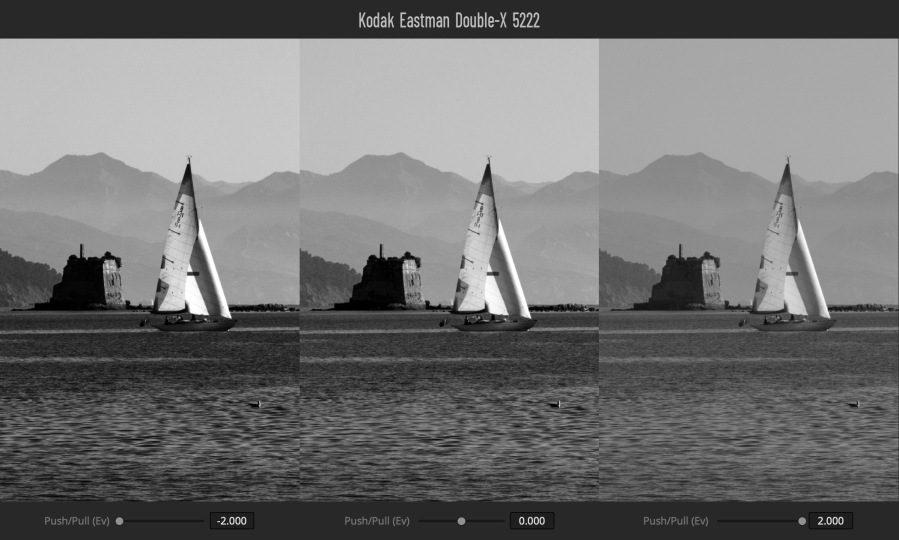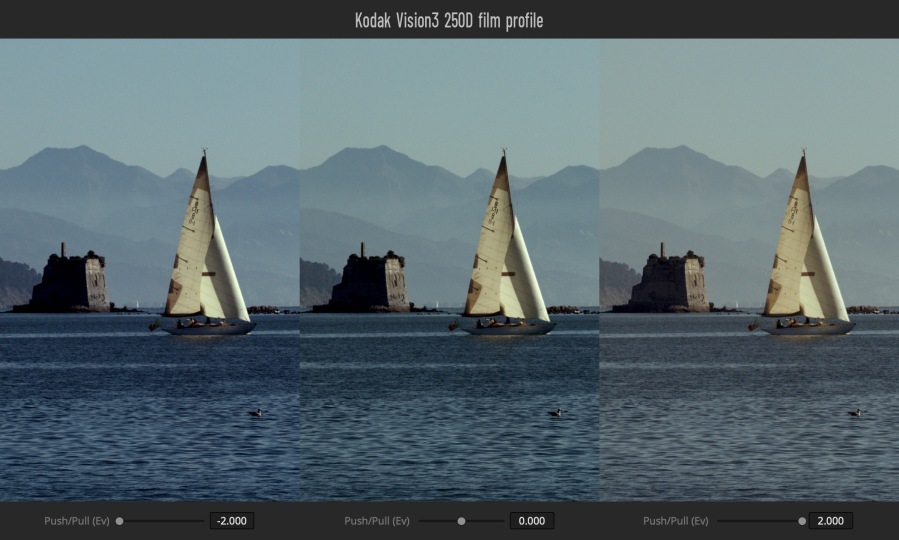All films behave differently depending on how much light they received during exposure.
Therefore, each film profile in Dehancer Film in fact consists of 3 separate profiles. Each profile is defined by its own sampling conditions:
- Normal exposure
- Underexposed –2 Ev
- Overexposed +2 Ev
Exposure correction during shooting is a creative tool that allows you to vary color-contrast look of each film.
In Dehancer Film exposure control is implemented with the Push/Pull (Ev) tool. This parameter allows one to set any exposure continuously between film states within -2 to +2 stops of exposure index (ie, within 5 stops total).
Changes in the Push/Pull setting result in darker or lighter image, changing color and contrast – just like with real film. Film type defines the character of changes.
B&W negative films
Classic Push/Pull process initially originates exactly from black and white film behaviour.

The original Push/Pull task is to control image contrast (not its brightness, as it is often mistakenly assumed). In order to obtain a more contrasting image, the film needs to be underexposed and overdeveloped. In order to get a less contrasting image, the opposite is true – overexpose and under-expose.
Push/Pull was originally designed to control image contrast (rather than brightness, as it is often misunderstood). In order to obtain more contrast, film must be underexposed and overdeveloped. And contrary, in order to get less contrast – overexposure and underdevelopment is needed.
In this case, the image almost does not change its density (‘brightness’, if we talk about viewing the scan on the monitor). That’s because negative exposure index is taken into account when processing the film – so development or printing process is aimed to get normal density.
Color negative films
Color negative is the most commonly used film type.
Its behaviour is similar to that of black and white films, but with less impact to image contrast. Contrarily, color changes are usually more pronounced and therefore provide rich opportunities for different creative tasks.

Color negative photographic films often (but not always) produce more expressed colors when overexposed between 0 and +2 Ev stops.
Color negative movie films, primarily Kodak Vision family, often (but not always) produce more interesting colors when underexposed in range of 0 to -1 steps (sometimes more).
Depending on the scene and lighting conditions, color negatives may produce interesting results for both underexposure (negative Push/Pull values) and overexposure (positive Push/Pull values).
Color reversal (slide) films
Usually slide film processing is incapable to compensate exposure errors (mistakes or intentional misuse). When printing from slide film (such technologies exist) it is even more difficult to compensate exposure shift, because we are dealing with a ready-to-view picture, that already has high contrast (and this is the meaning of slide film).
Therefore, depending on the exposure method and thus the Push/Pull parameter in the Dehancer Film, slide inevitably becomes darker or lighter.

Image color and contrast changes along with the brightness. As with analogue positive film, excessive slide underexposure usually leads to loss of detail in shadows and excessive overexposure results in flat (clipped) highlights.
In real life, when shooting on color reversible film, a small exposure correction is often made within -1/3 to -1 steps (sometimes more). This guarantees that no highlight details will be lost due to overexposure and additionally produces denser and richer colors.
B&W reversal (slide) films
Black and white slides behave similarly to color ones. Image becomes darker when underexposed and lighter when overexposed. Brightness changes along with contrast.

Similarly, underexposure may result in loss of detail in shadows and overexposure leads to highlights clipping.
Both positive and negative exposure correction is used sometimes as a creative tool, but rarely exceeds -1 / to +1 stops value.
Notes
1. Strictly speaking, Push/Pull process is a way of exposing films + a method of their subsequent processing (development and/or printing). In other words, this applies mostly to the negative movie/photo films, as they are designed for significant color-contrast correction during processing.
Push process: film is underexposed with subsequent overdevelopment (and/or appropriate exposure compensation when printing).
Pull process: film is overexposed with subsequent underdevelopment (and/or appropriate exposure compensation when printing).
2. The wet collodion process (ambrotype) requires special consideration, because in this case we get a negative image on the transparent glass, which is perceived as negative when viewed through, and simultaneously becomes positive when viewed on a black background. However, as Dehancer Film uses positive image of the ambrotype (intended viewing conditions), it can be roughly treated as ‘positive film’.
3. It also makes sense to mention the terminology nuances related to the words ‘Push’ and ‘Pull’. Usually, when used out of context, positive correction values are indicated by the word ‘Push’ while negative values marked by word ‘Pull’. However, if the combined term ‘Push/Pull’ is used, the signs change to their opposites.
Example:
Push +2 = Push/Pull -2
Pull -2 = Push/Pull +2
Explanation is simple. ‘Push’ and ‘Pull’ words are basically used separately when talking about film development process. For example, ‘Push +2’ means that film has to be overdeveloped 2 stops (i.e. that it was underexposed 2 stops). The combined term ‘Push/Pull’ refers to the combined exposure + development method, and the stops are counted relative to the shooting process rather than the development. For example, ‘Push/Pull -2’ means that film was underexposed by 2 stops and therefore has to be overdeveloped the same value.
4. We decided to keep Dehancer Film interface clean of redundant technical stuff that is rarely used for creative purposes when choosing a color-contrast solution depending on ‘exposure’ and ‘processing’ criteria.
Therefore, for simplicity and convenience we use the general term Push/Pull (Ev), well known in the world of analogue photography and movie production. Regardless of the film type and process, this parameter means:
- for negative films – the way of exposure and processing
- for reversal (slide) films – method of exposure only
Anyway, when a film profile is applied in Dehancer Film, if you move the Push/Pull slider to the left (negative values), underexposed film sample comes into effect. When moving slider to the right (positive values), overexposed sample is used progressively.
Read more about how Dehancer Film works in other articles.
Download actual Dehancer Film version:
https://www.dehancer.com
For a 2-week Promo license, please request to [email protected].
Authors:
© Pavel Kosenko
© Dmitry Novak
© Denis Svinarchuk

